flat tire CADILLAC SEVILLE 1995 4.G Owners Manual
[x] Cancel search | Manufacturer: CADILLAC, Model Year: 1995, Model line: SEVILLE, Model: CADILLAC SEVILLE 1995 4.GPages: 410, PDF Size: 19.98 MB
Page 12 of 410
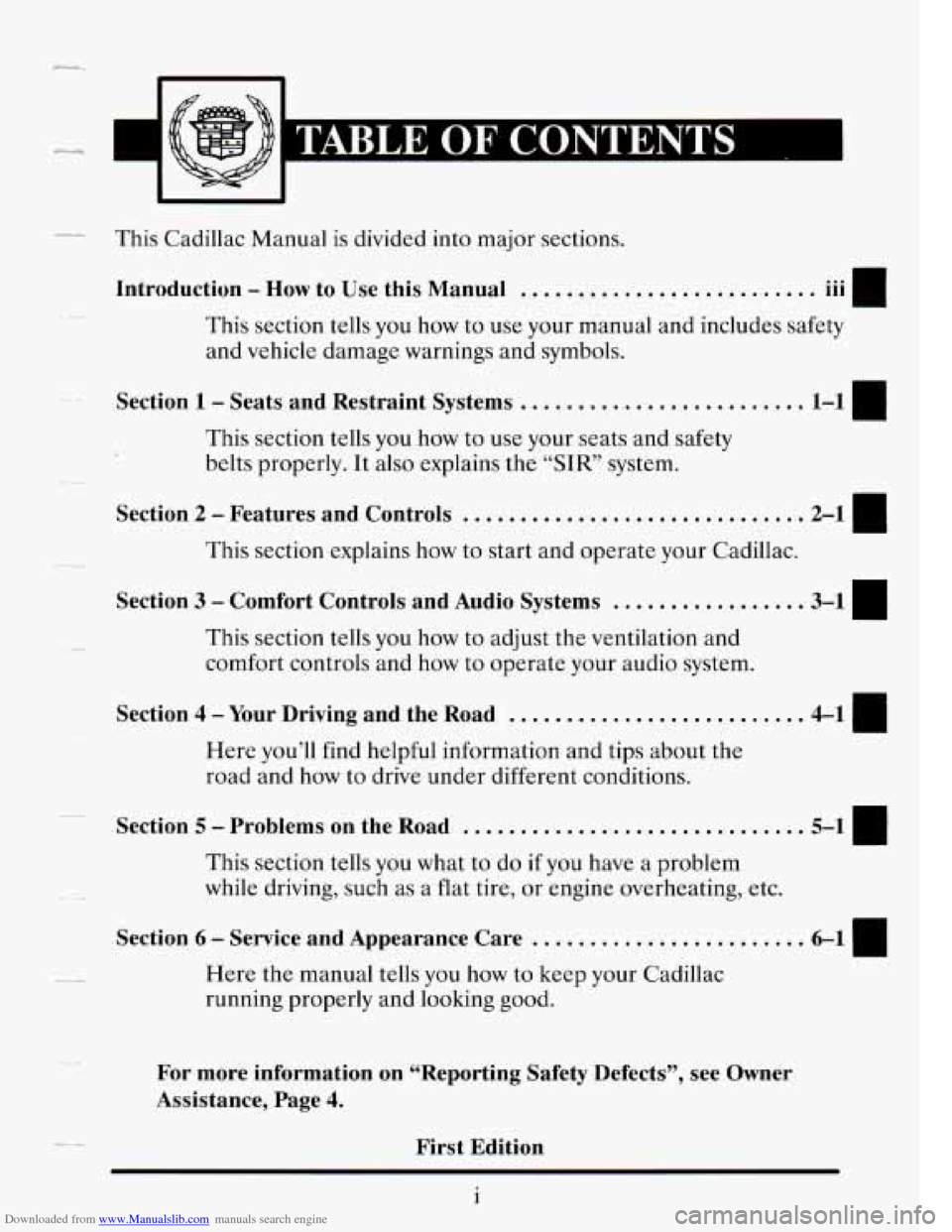
Downloaded from www.Manualslib.com manuals search engine This Cadillac Manual is divided into major sections.
Introduction - How to Use this Manual .......................... 111
This section tells you how to use your manual and includes safety
and vehicle damage warnings and symbols.
.-- I
Section 1 - Seats and Restraint Systems ......................... 1-1
This section tells you how to use your seats and safety
belts properly. It also explains the “SIR’ system.
Section 2 - Features and Controls .............................. 2-1 I
This section explains how to start and operate your Cadillac.
Section 3 - Comfort Controls and Audio Systems ................. 3-1
This section tells you how to adjust the ventilation and
comfort controls and how
to operate your audio system.
Section 4 - Your Driving and the Road .......................... 4-1
Here you’ll find helpful information and tips about the
road and how to drive under different conditions.
Section 5 - Problems on the Road .............................. 5-1
This section tells you what to do if you have a problem
while driving, such as a flat tire, or engine overheating, etc.
Section 6 - Service and Appearance Care ........................
Here the manual tells you how to keep your Cadillac
running properly and looking
good.
6-1 I
For more information on ‘(Reporting Safety Defects”, see \
Owner
Assistance, Page
4.
First Edition
1
Page 218 of 410
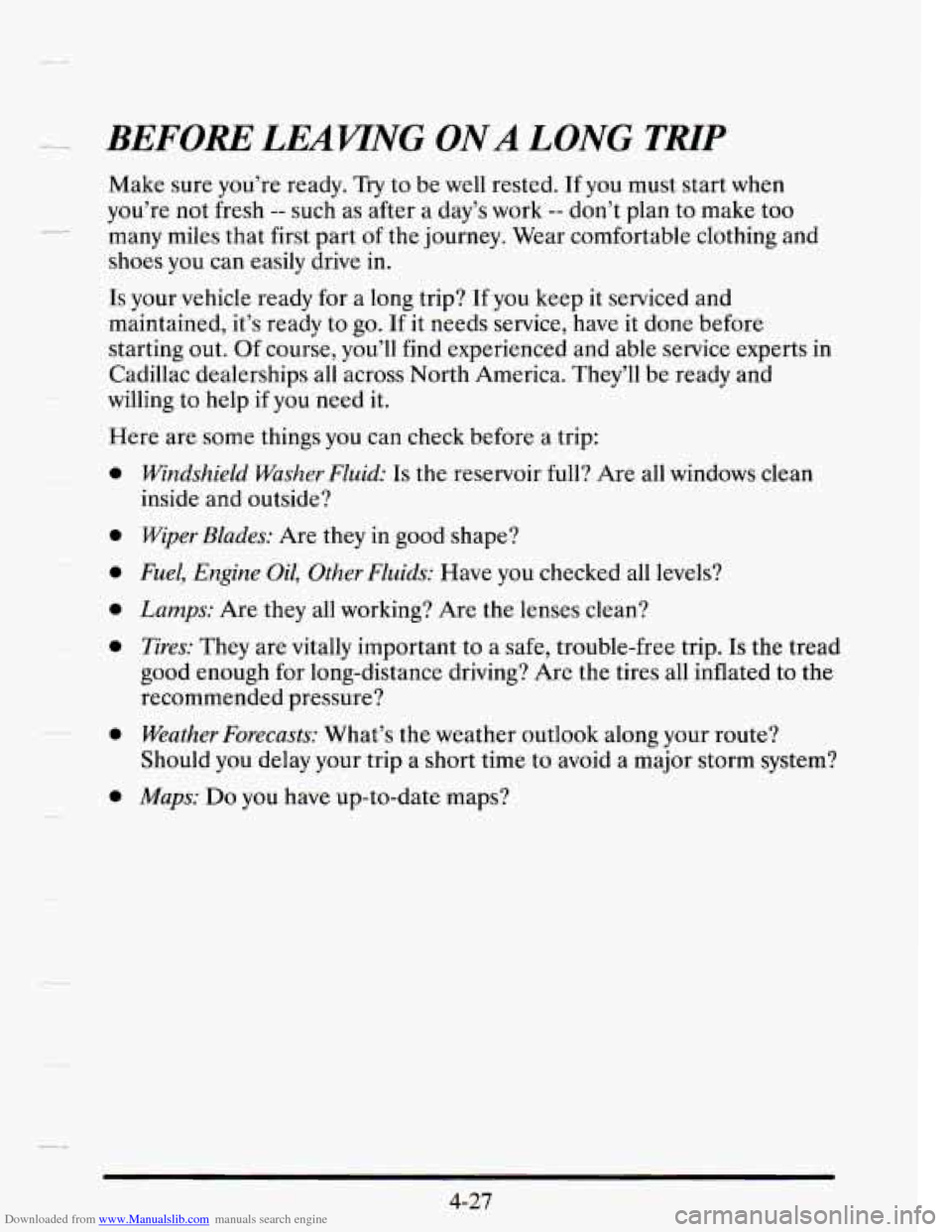
Downloaded from www.Manualslib.com manuals search engine - - .- BEFORE LEAVTNG ONA LONG TRlP
Make sure you’re ready. Try to be well rested. If you must start when
you’re not fresh
-- such as after a day’s work -- don’t plan to make too
many miles that first part
of the journey. Wear comfortable clothing and
shoes you can easily drive in.
Is your vehicle ready for a long trip? If you keep it serviced and
maintained, it’s ready to go.
If it needs service, have it done before
starting out.
Of course, you’ll find experienced and able service experts in
Cadillac dealerships all across North America. They’ll be ready and
willing to help
if you need it.
_1
Here are some things you can check before a trip:
0
0
0
0
0
0
0
Windshield Washer Fluid: Is the reservoir full? Are all windows clean
inside and outside?
Wiper Blades: Are they in good shape?
Fuel, Engine Oil, Other Fluids: Have you checked all levels?
Lamps: Are they all working? Are the lenses clean?
Tires: They are vitally important to a safe, trouble-free trip. Is the tread
good enough for long-distance driving? Are the tires all inflated to the
recommended pressure?
Weather Forecasts: What’s the weather outlook along your route?
Should you delay your trip a short time to avoid a major storm system?
Maps: Do you have up-to-date maps?
Page 220 of 410
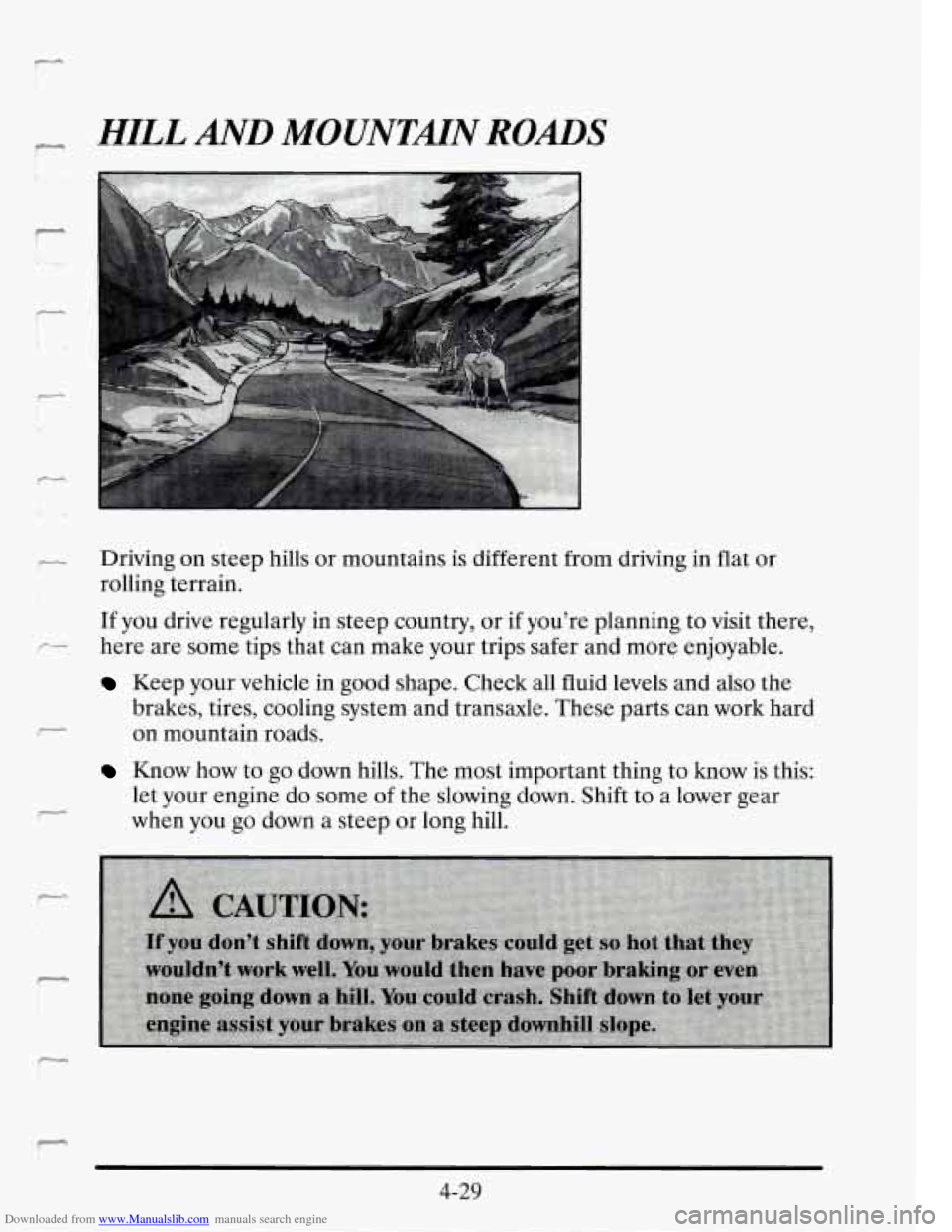
Downloaded from www.Manualslib.com manuals search engine P
c1 HILL AND MOUNTMN ROADS
- Driving on steep hills or mountains is different from driving in flat or r* I rolling terrain.
If you drive regularly in steep country, or if you're planning to visit there,
p- here are some tips that can make your trips safer and more enjoyable.
r
,-
Keep your vehicle in good shape. Check all fluid levels and also the
brakes, tires, cooling system and transaxle. These parts can work hard
on mountain roads.
Know how to go 'down hills. The most important thing to know is this:
let your engine do some
of the slowing down. Shift to a lower gear
when you
go down a steep or long hill.
r
4-29
Page 228 of 410
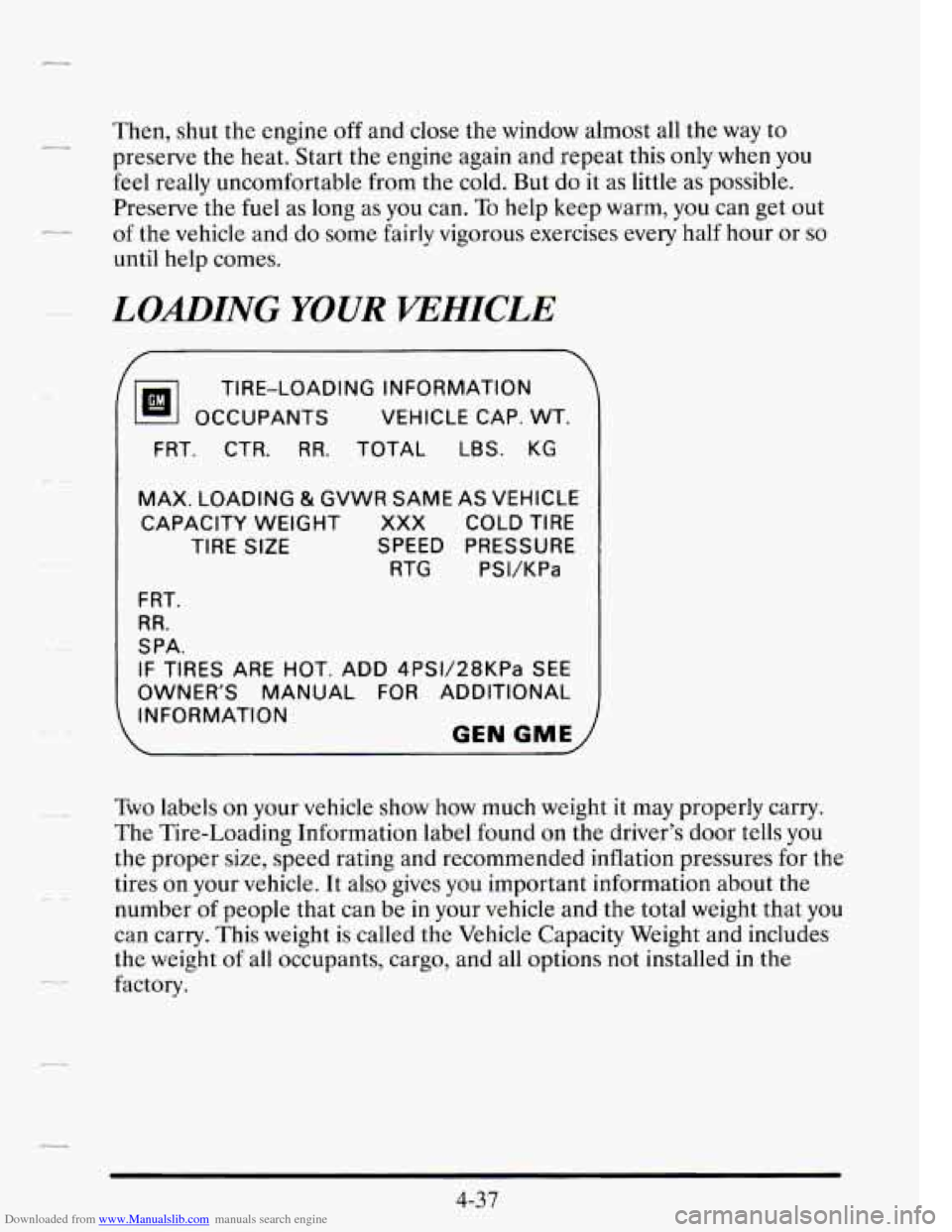
Downloaded from www.Manualslib.com manuals search engine -- -
Then, shut the engine off and close the window almost all the way to
preserve the heat. Start the engine again and repeat this only when you
feel really uncomfortable from the cold. But do it as little as possible.
Preserve
the fuel as long as you can. To help keep warm, you can get out
of the vehicle and do some fairly vigorous exercises every half hour or so
until help comes.
LOADING YOUR VEHICLE
OCCUPANTS VEHICLE
CAP. WT.
TIRE-LOADING INFORMATION
FRT. CTR.
RR. TOTAL LBS. KG
MAX. LOADING
& GVWR SAME AS VEHICLE
CAPACITY WEIGHT XXX COLD TIRE
TIRE
SIZE SPEED PRESSURE RTG PSVKPa
F RT.
RR.
SPA.
IF TIRES ARE
HOT. ADD 4PSV28KPa SEE
OWNER'S MANUAL FOR ADDITIONAL
INFORMATION
GEN GME 1
Two labels on your vehicle show how much weight it may properly carry.
The Tire-Loading Information label found
on the driver's door tells you
the proper size, speed rating and recommended inflation pressures for the
tires on your vehicle. It also gives you important information about the
number
of people that can be in your vehicle and the total weight that you
can carry. This weight is called the Vehicle Capacity Weight and includes
the weight of all occupants, cargo, and all options
not installed in the
factory.
4-37
Page 234 of 410
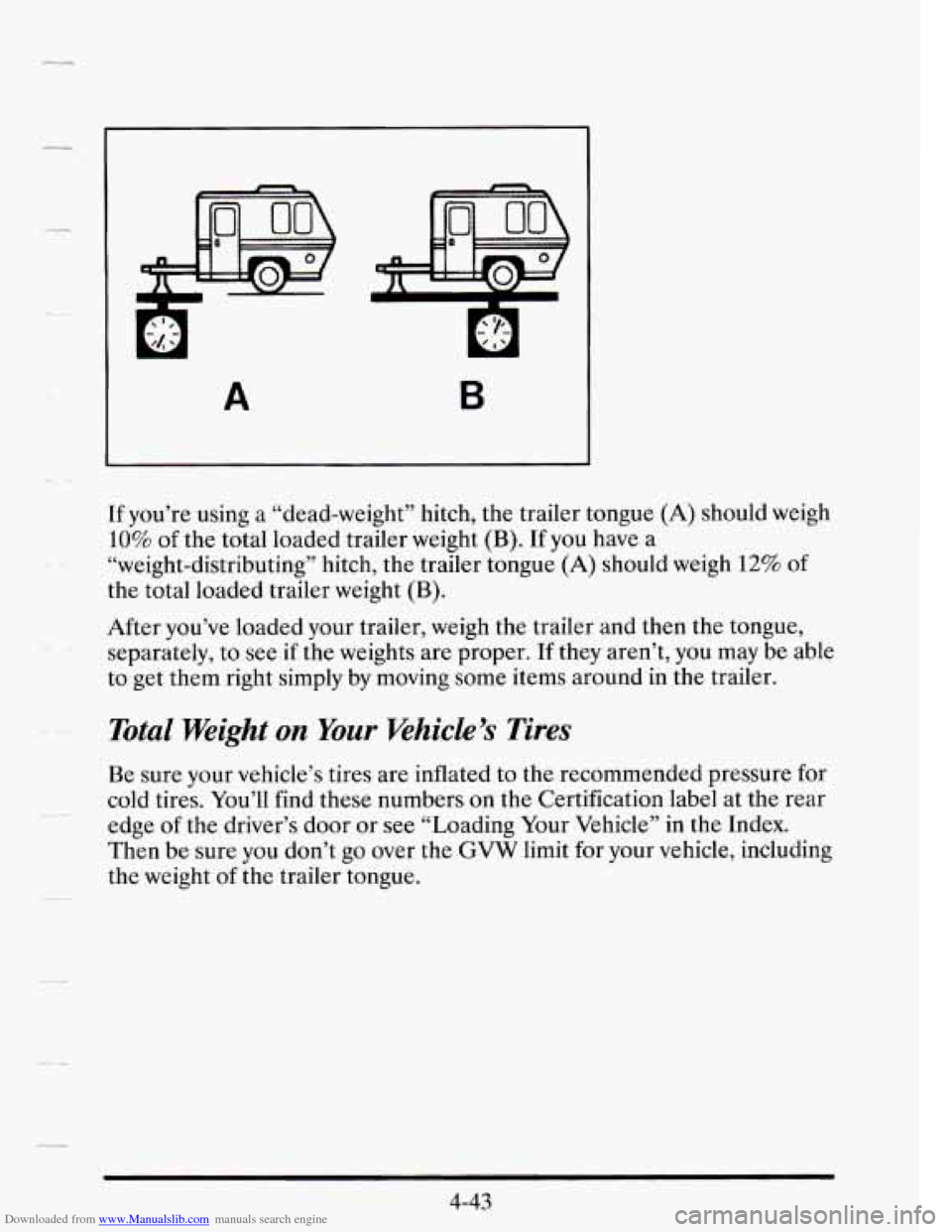
Downloaded from www.Manualslib.com manuals search engine -I
--_
A B
If you’re using a “dead-weight” hitch, the trailer tongue (A) should weigh
10% of the total loaded trailer weight (B). If you have a
“weight-distributing” hitch, the trailer tongue
(A) should weigh 12% of
the total loaded trailer weight
(B).
After you’ve loaded your trailer, weigh the trailer and then the tongue,
separately, to see
if the weights are proper. If they aren’t, you may be able
to get them right simply by moving some items around in the trailer.
Total Weight on Your khicle’s Tires
Be sure your vehicle’s tires are inflated to the recommended pressure for
cold tires. You’ll find these numbers
on the Certification label at the rear
edge
of the driver’s door or see “Loading Your Vehicle” in the Index.
Then be sure you don’t go over the
GVW limit for your vehicle, including
the weight
of the trailer tongue.
4-43
Page 260 of 410
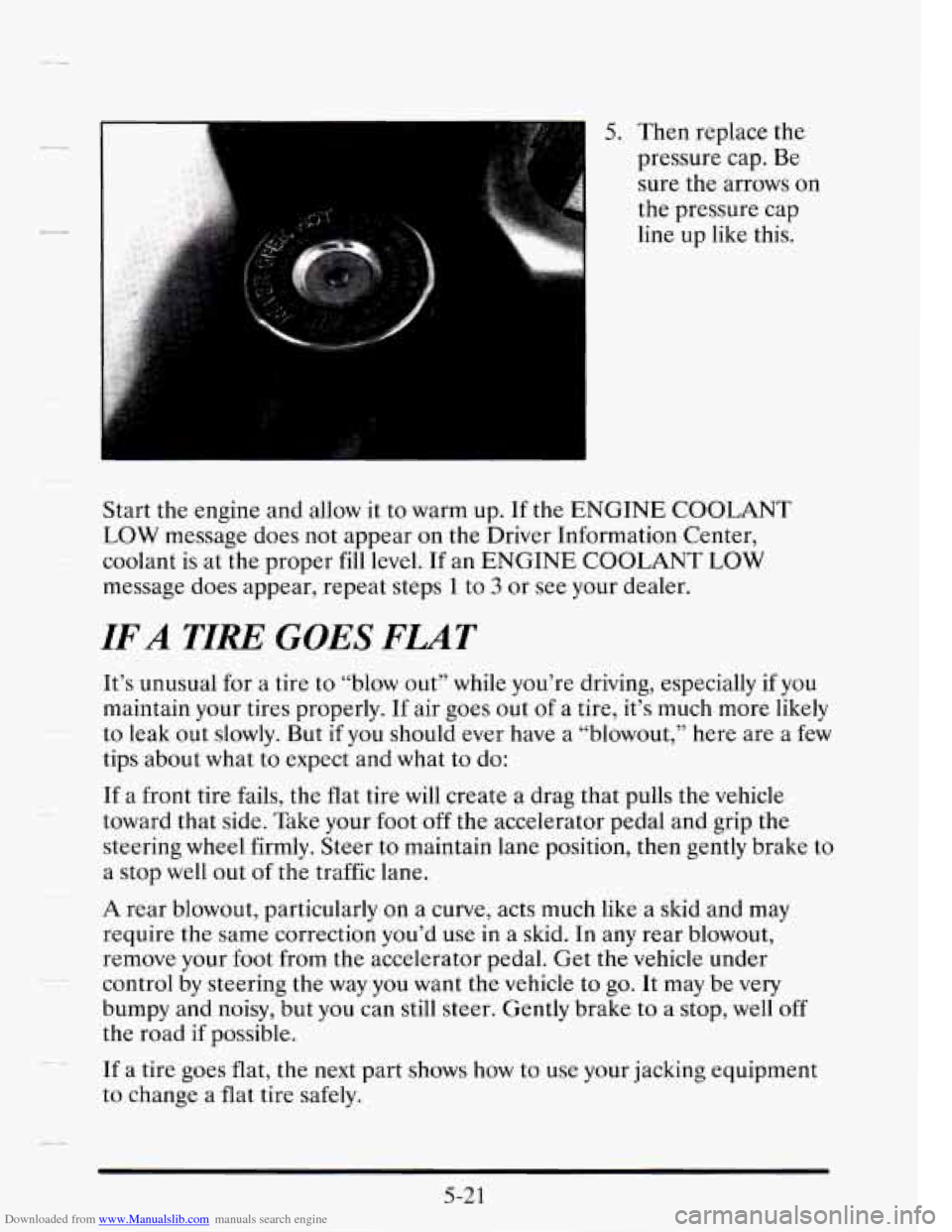
Downloaded from www.Manualslib.com manuals search engine 5. Then replace the
pressure
cap. Be
sure the arrows on
the pressure cap
line up
like this.
Start the engine and allow
it to warm up. If the ENGINE COOLANT
LOW message does not appear on the Driver Information Center,
coolant
is at the proper fill level. If an ENGINE COOLANT LOW
message does appear, repeat steps 1 to 3 or see your dealer.
IFA TIRE GOES FLAT
It’s unusual for a tire to “blow out” while you’re driving, especially if you
maintain your tires properly.
If air goes out of a tire, it’s much more likely
to leak out slowly. But if you should ever have a “blowout,” here are a few
tips about
what to expect and what to do:
If a front tire fails, the flat tire
will create a drag that pulls the vehicle
toward that side. Take your foot off the accelerator pedal and grip the
steering wheel firmly. Steer to maintain lane position, then gently brake to
a stop well out of the traffic lane.
A rear blowout, particularly on a curve, acts much like a skid and may
require the same correction you’d use in a skid. In any rear blowout,
remove your foot from the accelerator pedal. Get the vehicle under
control by steering the way you want the vehicle
to go. It may be very
bumpy and noisy, but you can still steer. Gently brake to a stop, well off
the road
if possible.
If
a tire goes flat, the next part shows how to use your jacking equipment
to change a flat tire safely.
5-2 1
Page 261 of 410
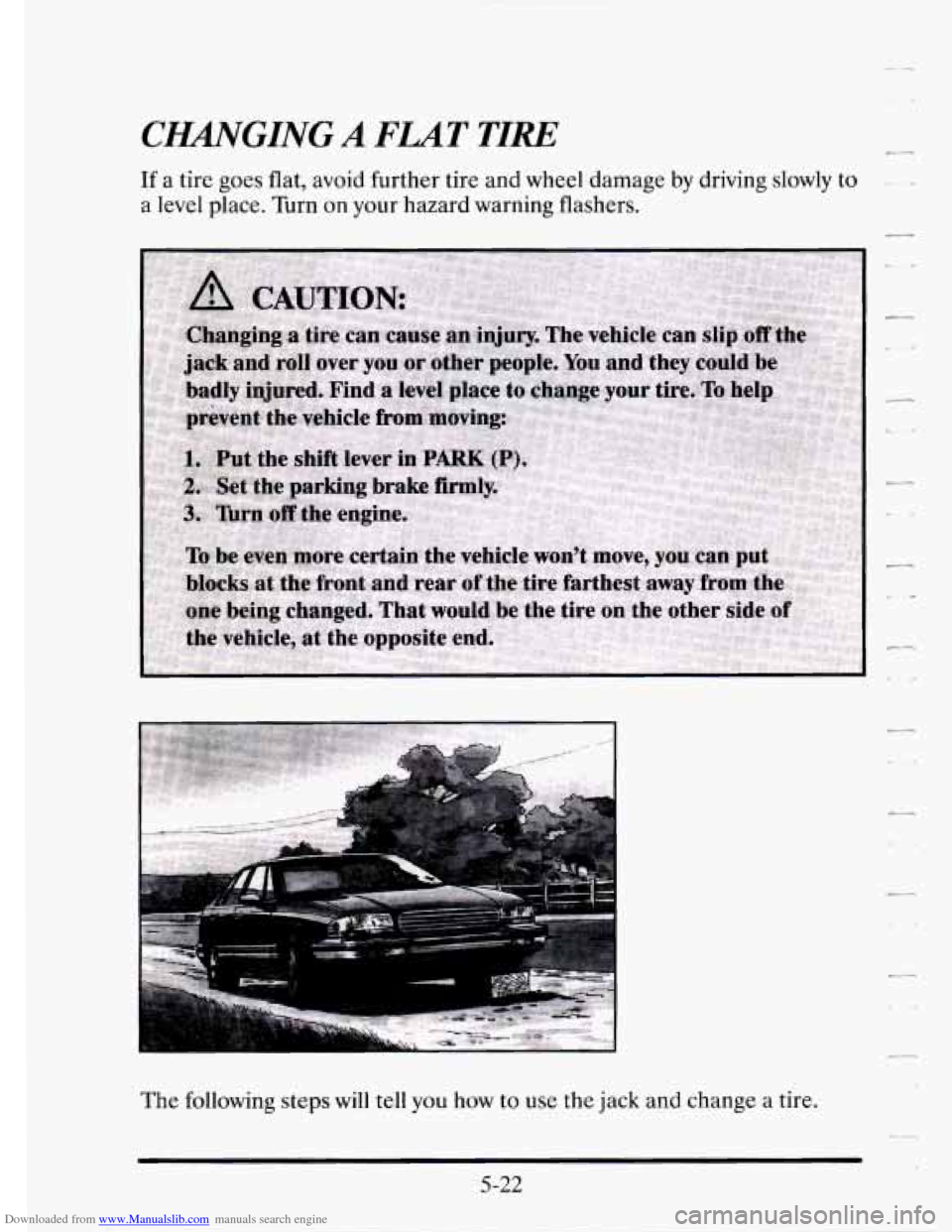
Downloaded from www.Manualslib.com manuals search engine C.GING A FLAT TIRE
If a tire goes flat, avoid further tire and wheel damage by driving slowly to
a level place. Turn on your hazard warning flashers.
The following steps will tell you how
to use the jack and change a tire.
5-22
Page 265 of 410
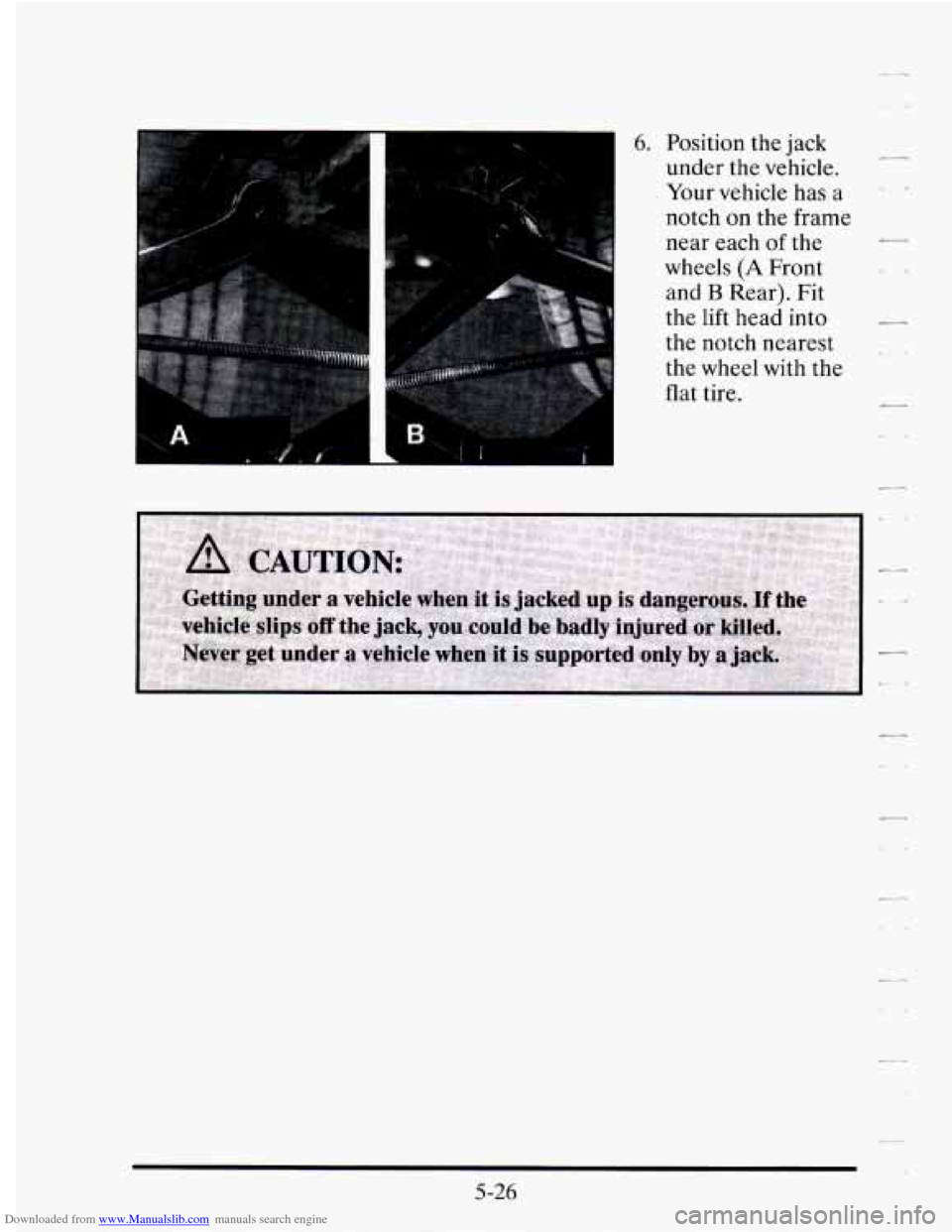
Downloaded from www.Manualslib.com manuals search engine 6. Position the jack
under the vehicle.
Your vehicle has a
notch on the frame
near each
of the
wheels
(A Front
and
B Rear). Fit
the lift head into
the notch nearest
the wheel with the
flat tire.
5-26
Page 266 of 410
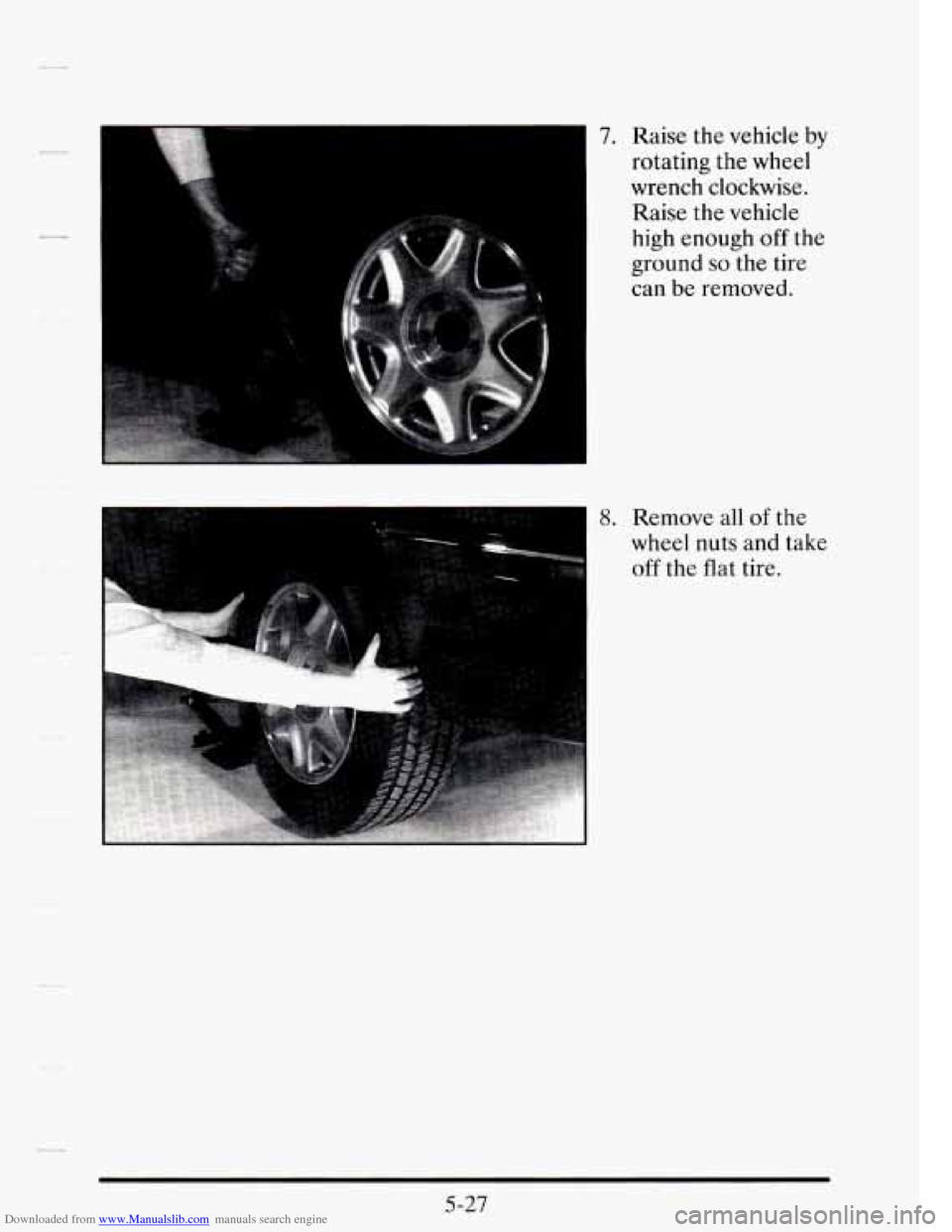
Downloaded from www.Manualslib.com manuals search engine 7. Raise the vehicle by
rotating the wheel
wrench clockwise.
Raise the vehicle
high enough
off the
ground
so the tire
can be removed.
1 8. Remove allof the
1 off the flat tire.
wheel nuts and take
Page 269 of 410
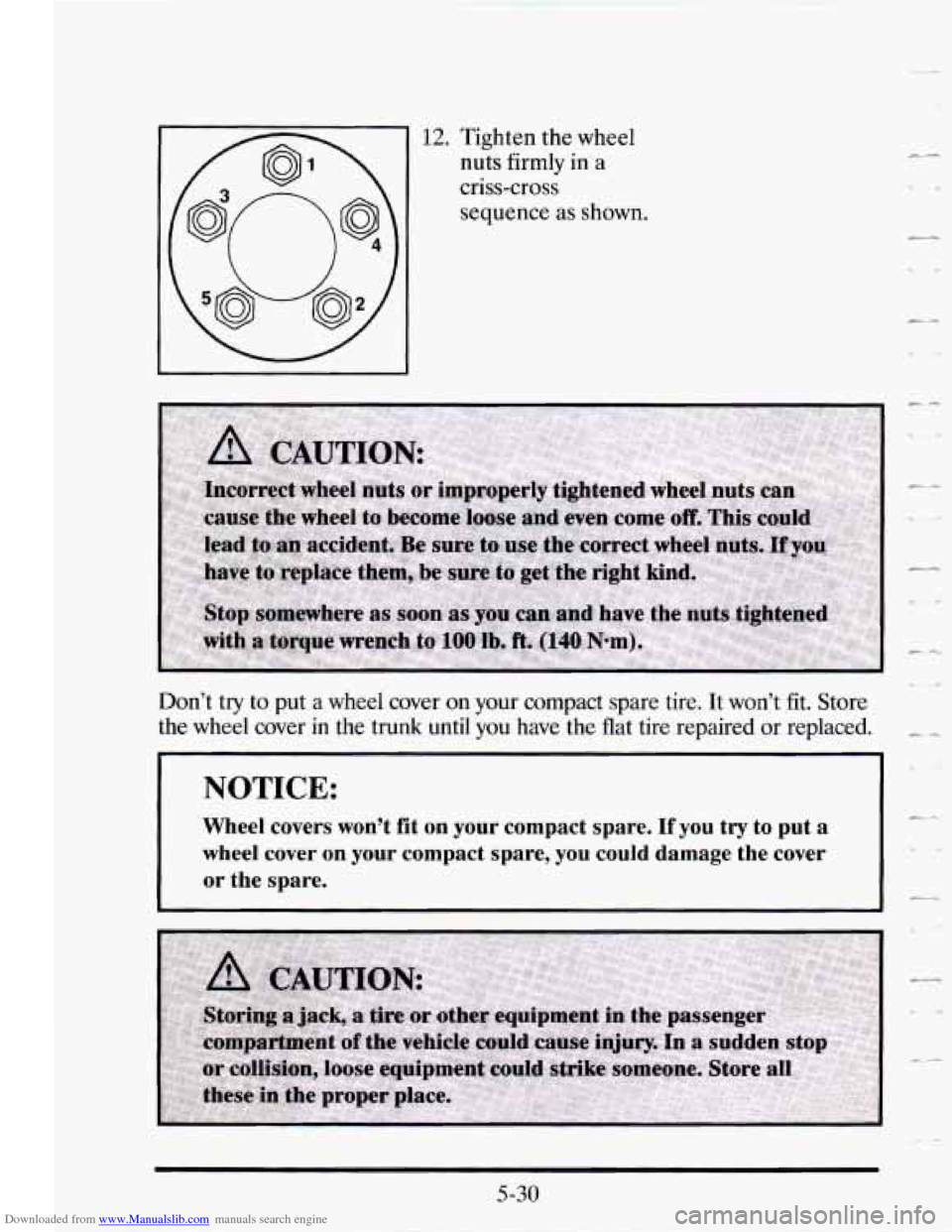
Downloaded from www.Manualslib.com manuals search engine 12. Tighten the wheel
nuts firmly
in a
criss-cross
sequence as shown.
Don’t try to put a wheel cover
on your compact spare tire. It won’t fit. Store
the wheel cover in the trunk until
you have the flat tire repaired or replaced.
NOTICE:
Wheel covers won’t fit on your compact spare. If you try to put a
wheel cover
on your compact spare, you could damage the cover
or the spare.
c-
&I
C-L
5-30